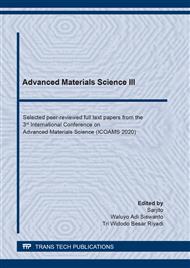[1]
V. Raj, A.N. Vijayan, K. Joseph, Cysteine capped gold nanoparticles for naked eye detection of E coli bacteria in UTI patients, Sens. Bio-Sensing Res., 5 (2015) 33–36.
DOI: 10.1016/j.sbsr.2015.05.004
Google Scholar
[2]
P.M. Shaibani, K. Jiang, G. Haghighat, M. Hassanpourfard, H. Etayash, S. Naicker, T. Thundat, The detection of Escherichia coli (E coli) with the pH sensitive hydrogel nanofiber-light addressable potentiometric sensor (NF-LAPS), Sensors Actuators, B Chem., 226 (2016) 176–183.
DOI: 10.1016/j.snb.2015.11.135
Google Scholar
[3]
H. Peng, I.A. Chen, Rapid Colorimetric Detection of Bacterial Species through the Capture of Gold Nanoparticles by Chimeric Phages, ACS Nano, 13 (2019) 1244–1252.
DOI: 10.1021/acsnano.8b06395
Google Scholar
[4]
Z. Hu, M. Xie, D. Yang, D. Chen, J. Jian, H. Li, K. Yuan, Z. Jiang, H. Zhou, A simple, fast, and sensitive colorimetric assay for visual detection of berberine in human plasma by NaHSO4-optimized gold nanoparticles, RSC Adv., 7 (2017) 34746–34754.
DOI: 10.1039/c7ra05291j
Google Scholar
[5]
C. Zhang, X. Wan, X. Zheng, X. Shao, Q. Liu, Q. Zhang, Dual-functional nanoparticles targeting amyloid plaques in the brains of Alzheimer's disease mice, Biomaterials, (2014).
DOI: 10.1016/j.biomaterials.2013.09.063
Google Scholar
[6]
M. Sabela, S. Balme, M. Bechelany, J.M. Janot, K. Bisetty, A Review of Gold and Silver Nanoparticle-Based Colorimetric Sensing Assays, Adv. Eng. Mater., 19 (2017) 1–24.
DOI: 10.1002/adem.201700270
Google Scholar
[7]
J. Chen, S. Andler, J. Goddard, S. Nugen, Integrating recognition elements with nanomaterials for bacteria sensing, Chem. Soc., (2017).
DOI: 10.1039/c6cs00313c
Google Scholar
[8]
P. Sondhi, M.H.U. Maruf, K.J. Stine, Nanomaterials for biosensing lipopolysaccharide, Biosensors, 10 (2020).
DOI: 10.3390/bios10010002
Google Scholar
[9]
F. Mouffouk, A.M. Rosa, J. Martins, M. Zourob, K.M. Abu-salah, S.A. Alrokayan, Biosensors and Bioelectronics Development of a highly sensitive bacteria detection assay using fluorescent pH-responsive polymeric micelles, Biosens. Bioelectron., 26 (2011) 3517–3523.
DOI: 10.1016/j.bios.2011.01.037
Google Scholar
[10]
Bivigou-Koumba, A.M. Kristen, J. Laschewsky, Buschbaum, A. Muller, C.M. P. Papadakis, Synthesis Of Symmetrical Triblock Copolymers Of Styrene And N-Isopropylacrylamide Using Bifunctional Bis(Trithiocarbonate)S As Raft Agents, Macromol. Chem. Phys., 210 (2009) 565–578.
DOI: 10.1002/macp.200800575
Google Scholar
[11]
S. Dai, P. Ravi, K.C. Tam, pH-responsive polymers: Properties, synthesis and applications, Smart Polym. Their Appl., (2014) 45–92.
Google Scholar
[12]
K. Sivaram, M.C. Rao, G. Giridhar, M. Tejaswi, B.T.P. Madhav, V.G.K.M. Pisipati, R.K.N.R. Manepalli, Synthesis and characterization of thiol - Capped silver nanoparticles and their effect on liquid crystals, Rasayan J. Chem., 10 (2017) 16–24.
DOI: 10.7324/rjc.2017.1011539
Google Scholar
[13]
P.K. Ngumbi, S.W. Mugo, J.M. Ngaruiya, Determination of Gold Nanoparticles Sizes via Surface Plasmon Resonance, IOSR J. Appl. Chem. (IOSR-JAC, 11 (2018) 25–29.
Google Scholar
[14]
A. Rohiman, I. Anshori, A. Surawijaya, I. Idris, Study of colloidal gold synthesis using Turkevich method, AIP Conf. Proc., 1415 (2011) 39–42.
DOI: 10.1063/1.3667215
Google Scholar
[15]
B.S. Srinath, V. Ravishankar Rai, Biosynthesis of highly monodispersed, spherical gold nanoparticles of size 4–10 nm from spent cultures of Klebsiella pneumoniae, 3 Biotech, 5 (2015) 671–676.
DOI: 10.1007/s13205-014-0265-2
Google Scholar
[16]
L.J. Sang, H.F. Wang, Aminophenylboronic-acid-conjugated polyacrylic acid-Mn-doped ZnS quantum dot for highly sensitive discrimination of glycoproteins, Anal. Chem., 86 (2014) 5706–5712.
DOI: 10.1021/ac501020b
Google Scholar
[17]
J. Qiao, H. Ding, Q. Liu, R. Zhang, L. Qi, Preparation of Polymer@AuNPs with Droplets Approach for Sensing Serum Copper Ions, Anal. Chem., 89 (2017) 2080–(2085).
DOI: 10.1021/acs.analchem.6b04722
Google Scholar
[18]
F. Reyes-Ortega, pH-responsive polymers: Properties, synthesis and applications, Woodhead Publishing Limited, (2014).
Google Scholar
[19]
H. Zhao, X. Wu, W. Tian, S. Ren, Synthesis and thermal property of poly(allylamine hydrochloride), Adv. Mater. Res., 150–151 (2011) 1480–1483.
DOI: 10.4028/www.scientific.net/amr.150-151.1480
Google Scholar
[20]
J.T. Buchman, A. Rahnamoun, K.M. Landy, X. Zhang, A.M. Vartanian, L.M. Jacob, C.J. Murphy, R. Hernandez, C.L. Haynes, Using an environmentally-relevant panel of Gram-negative bacteria to assess the toxicity of polyallylamine hydrochloride-wrapped gold nanoparticles, Environ. Sci. Nano, 5 (2018) 279–288.
DOI: 10.1039/c7en00832e
Google Scholar


